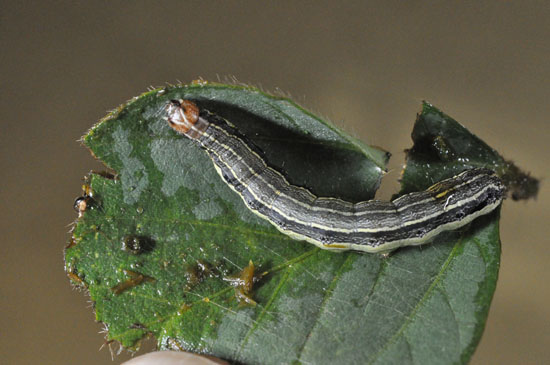Watch for fall armyworms
Watch for fall armyworms

Forage producers reseeding their drought-damaged pastures this fall will want to be on the lookout for fall armyworm as the new grass seedlings emerge, said Lee Townsend, extension entomologist with the University of Kentucky College of Agriculture.
“Fall armyworms feed at night and can destroy emerging grass and alfalfa stands in a very short period of time,” Townsend said.
Each year, fall armyworm moths migrate to Kentucky from the South and begin laying eggs. Larvae hatch within three to five days. Fall armyworms are active beginning in mid-summer and are around until the first killing frost. They will feed on newly established stands of grass and alfalfa. They will also feed on late-maturing soybeans when no forage is available, as may be the case in drought-stricken areas of Western Kentucky. This year, they have already damaged some bermudagrass pastures in southern Kentucky. Fall armyworm moth captures in the Integrated Pest Management traps at the UK Research and Education Center in Princeton jumped from zero the week of Aug. 2 to 549 captures the week of Aug. 16. Thus far, Lexington IPM traps have not captured any fall armyworm moths.
“Initially, infestations begin slowly,” Townsend said. “As emerging stands are becoming established, female moths will begin to lay masses of 200 or more eggs on grass blades. The small worms will hatch in a few days and start to feed.”
Their feeding, which occurs during the night, will result in small, brown patches in pastures that might be first mistaken for a rock or hardpan.
“As the worms feed and grow, the spots will increase in size and join with spots from nearby egg masses,” Townsend said.
If brown spots become visible in pastures, producers should look for fall armyworms underneath field debris or in soil cracks.
Soybean producers should scout their fields for fall armyworms. The worms usually feed on foliage but may feed on the pods too.
The pest varies in color from light tan to black with three yellow stripes down its back. The middle stripe is usually darker and the ones on each side are wavy and yellow-red blotched. Fall armyworm has a dark head with a light-colored, inverted "Y" mark on front.
Townsend said if producers find more than three worms within a square foot of their pasture, they may want to spray the field with an insecticide. For soybeans, treatment thresholds vary based on the amount of leaf feeding.
Insecticides provide the best control when the worms are 0.75 inches long or smaller. More information on the insecticides to control fall armyworms is available at local offices of the UK Cooperative Extension Service.
While fall armyworm is a pest of cattle and horse pastures, it should not affect horses. It should not be confused with the eastern tent caterpillar that causes mare reproductive loss syndrome. Fall armyworms appear in Kentucky only in late summer and fall. Eastern tent caterpillars appear in the spring.
Entomology Ag Equine Programs Extension Weather

